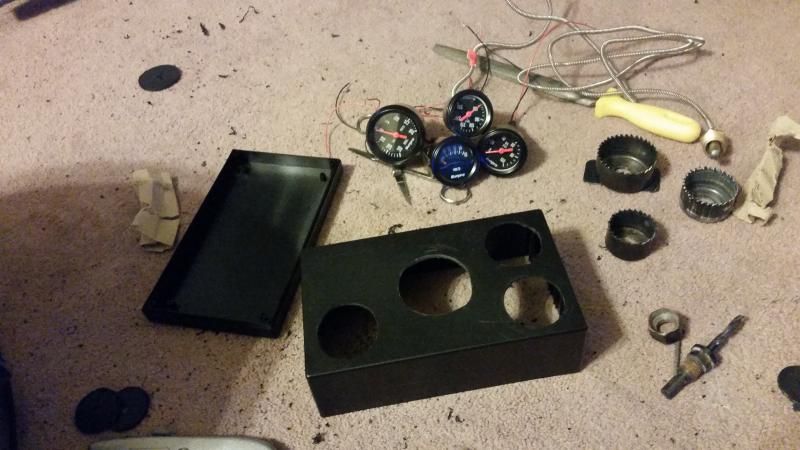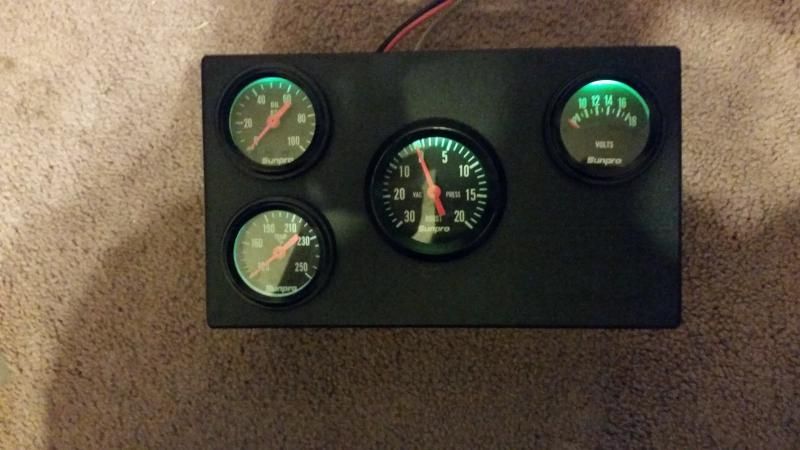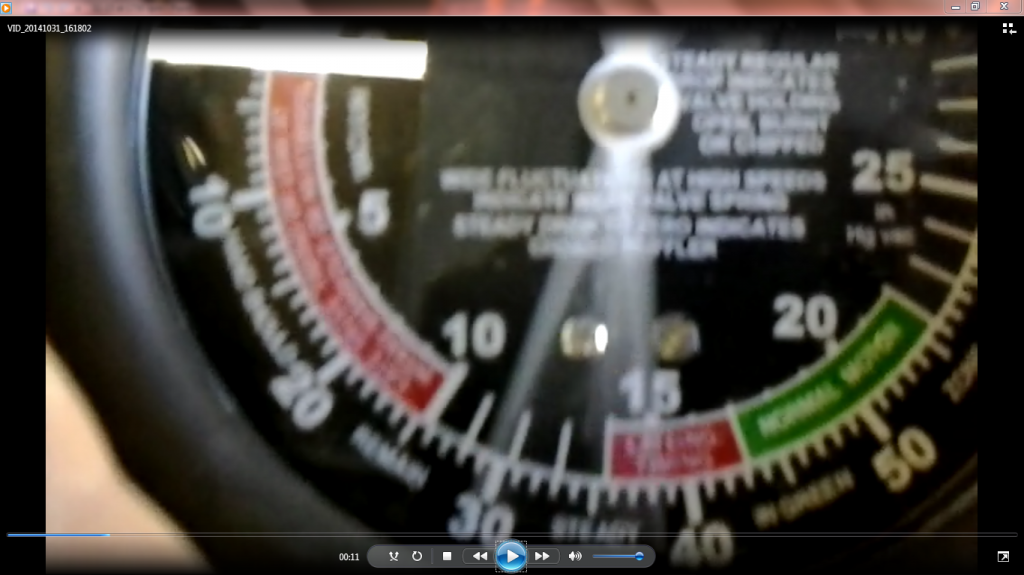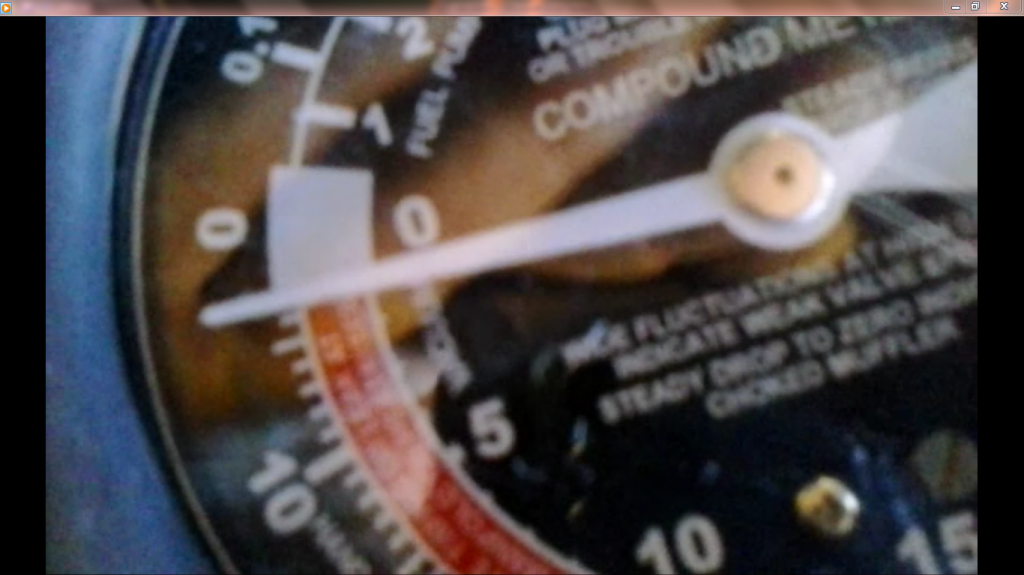|
|
Post by scooter on Oct 27, 2014 23:30:03 GMT -5
Using vacuum and fuel pressure gauges to take the guesswork out of diagnosing engine trouble. We've been discussing common issues on here like vacuum leaks, fuel cutout and so on, and I think it makes sense to use gauges to get data about what's really going on in our engines when these problems occur. I'm getting a vacuum and pressure gauge. I want to know if I have enough vacuum and what my vacuum pressure is at different RPMs, and how well my fuel pump is working at various RPMs. I might even plug up all of my vacuum lines and do a leak test to see if that's a problem. I'm hoping this will lead to a better knowledge of my engine and how it works. I've even read that you can diagnose valve setting and timing issues with this tool. What about you? Have you used these gauges? How useful are or were they to you? What kind of things did you use them to diagnose? Also here is a post about some gauges I found online if you're interested. Feel free to add to it. itistheride.boards.net/thread/6944/good-vacuum-pressure-gauge-testingHere is a video of a guy using a gauge just like the one I bought, and it sounds like he's reading the manual that comes with it. Interesting stuff. |
|
|
|
Post by scooter on Oct 28, 2014 21:20:32 GMT -5
I think I'll hook it up to the shop vac and see what it reads.  |
|
|
|
Post by scooter on Oct 30, 2014 15:25:47 GMT -5
Got my new vacuum and fuel pressure gauge in today, and boy is it huge!  It takes up most of my hand. It's like the diameter of a can of beef stew! mmmm beef stew.  I can't wait to try it out. I will try it out a little later.  I am looking forward to getting some readings for my data collection. |
|
|
|
Post by toddmaples on Oct 30, 2014 16:08:32 GMT -5
Got my new vacuum and fuel pressure gauge in today, and boy is it huge! ::)It takes up most of my hand. It's like the diameter of a can of beef stew! mmmm beef stew.  oh so I can't wait to try it out. I will try it out a little later.  I am looking forward to getting some readings for my data collection. Maybe you could play Mythbusters with the common PCV valve people install on the valve cover vent line and post readings with and without it... |
|
|
|
Post by dmartin95 on Oct 31, 2014 1:15:34 GMT -5
I'm really big into utilizing gauges... I am adding a bunch of gauges to my scooter.... I'm waiting on a new instrument cluster and for the first snow to fly. My new instrument cluster is digital and the number one reason I got it was for the built in tachometer (im trying to cram a bunch of gauges in a little space). I purchased a small project box for the housing and some handlebar mounts from ebay for cheap... I also ditched the 12V, 5 watt lights and replaced them with 200ma LEDs. Here's where my project is at so far....    |
|
|
|
Post by scooter on Oct 31, 2014 3:28:27 GMT -5
I'm really big into utilizing gauges... I am adding a bunch of gauges to my scooter.... I'm waiting on a new instrument cluster and for the first snow to fly. My new instrument cluster is digital and the number one reason I got it was for the built in tachometer (im trying to cram a bunch of gauges in a little space). I purchased a small project box for the housing and some handlebar mounts from ebay for cheap... I also ditched the 12V, 5 watt lights and replaced them with 200ma LEDs. Here's where my project is at so far.... That looks nice. There is much I'd like to know about what's going on my engine, especially air/fuel ratio and temperature. Oil pressure and temp gauges should be minimal equipment on anything with a gas engine and I have neither. |
|
|
|
Post by scooter on Oct 31, 2014 16:11:45 GMT -5
Got my new vacuum and fuel pressure gauge in today, and boy is it huge! ::)It takes up most of my hand. It's like the diameter of a can of beef stew! mmmm beef stew.  oh so I can't wait to try it out. I will try it out a little later.  I am looking forward to getting some readings for my data collection. Maybe you could play Mythbusters with the common PCV valve people install on the valve cover vent line and post readings with and without it... What myth are we busting, Todd? |
|
|
|
Post by scooter on Oct 31, 2014 16:31:32 GMT -5
Okay, here are my first readings. Feel free to add your own and to comment on what you see here. These readings were taken by putting a "T" on the fuel pump's vacuum port. This is actual vacuum delivered to the pump while the bike is on the center stand. To note, I am able to go top speed, a little over 60mph and over 8000 rpm without bogging or shutting down. First are the readings from the fuel pump outlet. Note the apparent drop in psig at 8000 rpm. This is a 150cc HS1P57QMJ type "A" GY6 clone long case with stock carb and airbox and all of the emissions still on it. I am currently using a 120 main jet, however I will be switching back to the 115 which seems to work noticeably better, especially on top end power. It is interesting that as rpm goes up, fuel pressure rises as vacuum drops.
This would indicate that a lot of little pulses on the fuel pump vacuum produces more power than a fewer number of larger pulses. I wish I had gotten matching rpm readings but apparently I had a brain fart. I did get 7000 for both. Still it is clear that while vac pressure drops, the pump makes up for it in pulses per minute, at least until the very upper rpm range, where it begins to taper off.
We also have some baseline measurements for an electric pump, flow and pressure being about 1gph@4psi, leaks included. Several drops of fuel leaking per second but nothing compared to what the pump is pumping out. I'd say if you did 1.5 or 2X those numbers you'd have a good pump for a stock 150gy6. Then again, this is not under load. I will try to get some actual on the road measurements tomorrow.Here are the readings at the fuel pump outlet. i had some fuel leakage on my test setup but hopefully it won't hurt the readings too much: fuel pressure 1.5 psig at 1500 rpm 2.6 psig at 5000 rpm 4 psig at 7000 rpm 3.5 psig at 8000 rpm vacuum(IN) rpm 11-15 1750 steady oscillating between 11 and 15 inches 11 4500 steady 6 5500 steady 4.5 6500 steady 3 7000 steady 1.5 7500 steady 1 8000 steady 0-20 goosing. goosing the throttle at idle makes vac go from 0 to 20 then back to 11-15 oscillation 11-15 in at 1750rpm titan mp150-02 vac readings on center stand when idling it ocsillates like this. all other readings were steady on one number.  1 in at 8000 rpm titan mp150-02 vac readings on center stand  Let me know what you think. |
|
|
|
Post by rcq92130 on Nov 1, 2014 18:28:23 GMT -5
VERY INTERESTING!!!!!!!!!!!!!!!!!!
1. So you are also getting vac readings around low teens at idle. Good to now that seems to be "normal" vac for these little mouse fart engines.
2. Can't believe with vac that low the fuel pump even operates! Electric!
3. GREAT to see what normal fuel pressure is. THANKS! The small electric pump I have on now is clearly too much - have not measured, but the spec is 6 to 9 psi. Have been worried it is forcing fuel past the needle valve. The newer pump is rated 2 to 4 psi - PERFECT for this little engine! Think I'll then move the larger (psi-wise) electric pump over to the Goldwing, which has a mechanical pump that sucks and is an Islamic Terrorist. Thanks for the info!
|
|
|
|
Post by scooter on Nov 1, 2014 19:05:44 GMT -5
You are welcome. I'm glad to be of any help.
|
|
|
|
Post by dmartin95 on Nov 1, 2014 22:34:49 GMT -5
Okay, here are my first readings. Feel free to add your own and to comment on what you see here. Let me know what you think. I too think it's great to see real life numbers published. I have been considering adding an electronic fuel pump to my wife's scooter but didn't know what size of pump to get her... These numbers help me narrow that decision down. In fact, I started a thread trying to get someone to answer fuel questions, but received feedback with suggestions on how to fix it in a different way.... I don't think I got the answer I was looking for because people just didn't know.... When I get my gauges installed and operating, I will add to this thread also. This thread should be pinned in the tech help IMO. |
|
|
|
Post by scooter on Nov 2, 2014 1:02:54 GMT -5
When I get my gauges installed and operating, I will add to this thread also. This thread should be pinned in the tech help IMO. Thanks, Dmartin. That's very encouraging and I appreciate it. |
|
|
|
Post by xyshannen on Nov 2, 2014 12:09:51 GMT -5
Yup, thank you Scooter for posting this. It also has swayed me to going electric. Like I've said many times before, if our problem stems from a drop in vacuum, a better vacuum operated pump won't solve our issues.
|
|
|
|
Post by scooter on Nov 2, 2014 13:07:28 GMT -5
Yup, thank you Scooter for posting this. It also has swayed me to going electric. Like I've said many times before, if our problem stems from a drop in vacuum, a better vacuum operated pump won't solve our issues. Thanks and you know, I believe one could add a vacuum operated switch to turn the pump on whenever the engine was being turned over. That would eliminate accidentally leaving the pump turned on in case the ignition switch is left on. Just a thought. I just left my keys in the ignition for several hours on Friday. Good thing for me it didn't kill the battery. I'll have to add an ignition/key buzzer to my list of stuff to add to the scooter some day. Maybe have it buzz when key switch is on and have a vacuum switch shut it off while the engine is running. haha |
|
|
|
Post by rcq92130 on Nov 2, 2014 14:50:21 GMT -5
Scoot - if you decide to add an electric pump you will not need a buzzer (assuming you use an electrical relay to energize it. Thought you can't hear the pump at all when the engine is "on" --- if you accidently left the key "on" after killing the engine the pump would alert you. Not very loud, but I think enough so you would notice and realize the key was 'on".
|
|

